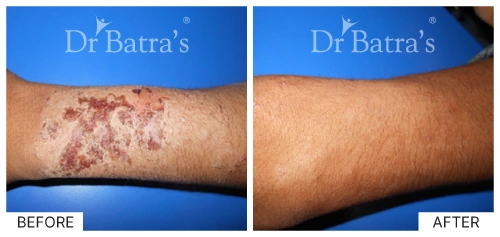Eczema Types
Eczema is a skin condition wherein patches of skin become inflamed, itchy, cracked, and rough causing blisters. According to the National Center for Biotechnology Information, symptoms of eczema were detected in 2.7% of children (In the age group of 6-7 years). Symptoms of severe eczema were detected in 0.3% of adults. The lifetime prevalence of eczema was 4.4% in the general population. Let's have an overlook at the common types of eczema:
-
Atopic dermatitis
:It is the most common form of eczema. It usually starts in childhood, and often gets milder or goes away by adulthood.
This type of eczema is brought on by an allergic response to the triggers, which can include foods or environmental allergens. Atopic describes a hereditary propensity for dermatitis, asthma, and hay fever, whereas dermatitis refers to red, itchy skin.
Atopic dermatitis cases are obvious when there is a family history of allergies, asthma, hay fever, etc. People with atopic dermatitis have an increased risk of environmental factors worsening their condition. They also usually see atopic dermatitis occur in conjunction with other allergic and sensitive disorders, such as rhinitis.
-
Contact dermatitis
:This type of eczema appears locally whenever an allergen or irritant comes into touch with the skin (allergic contact dermatitis) (irritant contact dermatitis). Eczema is typically brought on by prolonged interaction with allergens like food and other environmental factors. However, a brief duration of exposure to allergens might also cause an immediate eczema reaction.
One of the most prevalent types of contact dermatitis is an allergy brought on by contact with nickel, a material found in synthetic jewellery. This is also known as allergic contact eczema.
Besides red and itchy rashes, contact with chains, watches, rings, earrings, or other objects results in microscopic blisters and skin peeling.
-
Seborrhoeic dermatitis (Dandruff)
:It is an eczema type that commonly affects the head, the margins of the head, and the area behind the ears. This type of eczema shows features of reddish rashes with yellowish, oily flakes. It is commonly seen in people with oily skin and scalp and varies depending on the season.
It can often be seen in young children right after childbirth. This is known as ‘cradle cap’ and is caused due to the hormones passed on from mother to offspring. This is not of much concern as the symptoms fade away after about 6 months of birth.
-
Exfoliative dermatitis
:In this type of eczema, the patient experiences a large amount of scaling and flaking on the skin, covering almost the entire body.
-
Stasis dermatitis
:This eczema type occurs in areas of the body with poor blood circulation; e.g. the ankles. This type of eczema may develop into ulcers in the long run. It is mostly associated with circulatory disorders like varicose veins, among others.
-
Nummular dermatitis
:Nummular eczema, also known as nummular dermatitis or discoid eczema is a chronic type of eczema that causes coin-shaped spots to develop on the skin. These eczema spots are often itchy and well-defined. This eczema type may result in the oozing of clear fluid or dry and crusty skin in many cases.
-
Neuro-dermatitis
:It is an eczema type that develops due to emotional stress, wherein the patient feels intense skin itchiness, especially during resting or relaxing. This type of eczema usually limits itself to areas that are easily accessible to the individual such as the lower legs, ankles, back, and sides of the neck. It may also affect the wrists, forearms, and genitals.
-
Dyshidrotic eczema
:Dyshidrotic eczema or dyshidrosis eczema is a condition characterised by small fluid-filled blisters on the palms and fingers. This is also known commonly as eczema pompholyx.
This causes blisters on the hands and feet. These blisters come and go and cause itching and burning.
There may also be a sensation of prickling in the affected area. The blisters may often leak fluid. After the blistering phase, the skin may be cracked and sore. The skin may often bleed.
Medically Reviewed

Qualification
-
B.H.M.S (Maharashtra University of Health Sciences)
-
FCHD (Fellowship in Homeopathic Dermatologist - Mumbai)
References
- https://www.ncbi.nlm.nih.gov/books/NBK279399/
- https://kidshealth.org/en/parents/eczema-atopic-dermatitis.html
- https://my.clevelandclinic.org/health/diseases/9998-eczema
- https://www.mayoclinic.org/diseases-conditions/atopic-dermatitis-eczema/diagnosis-treatment/drc-20353279
- https://nationaleczema.org/eczema/treatment/
FAQs
Is Eczema The Same As Atopic Dermatitis?
Yes, it is a type of eczema, Atopic dermatitis (AD) is the most common type of eczema. impacting approximately 15 to 20% of children and 1 to 3% of adults worldwide. It’s a chronic skin condition that can come and go for years and can overlap with other types of eczema.
How Long Does Seborrheic Dermatitis Last On The Scalp?
Seborrheic dermatitis, sometimes known as "cradle cap," is common. The scalp, face, and intertriginous areas are among the potentially affected areas. Although there may be significant involvement, this condition often resolves on its own if the condition is milder it takes over 4-8 weeks to improve depending on the severity of the condition.
What are the common symptoms between the types of eczema?
Itching, inflamed skin, irritated skin, sensitive skin are some of the common symptoms between the types of eczema. Our doctors will differentiate your type of excess based in the signs and symptoms you present with and will then decide on the best treatment options for you.
How do doctors test for different types of eczema?
The most used methods to test for eczema are patch testing and allergy testing. These are done by placing small amounts of allergens on your skin and cover each allergen with a patch. The patch will be left on for 48 hours to see if it makes your symptoms worse. Sometime for people with eczema, they may also test for food allergies to rule out any food allergens that could be causing the flare ups.
Is there anything i can do to lessen my symptoms?
Some self help tips are known to lessen eczema symptoms. These include application of creams and ointments to keep the skin hydrated and moisturised. You are advised to apply moisturizer based on the level of dryness of your skin. Conventional treatment options for atopic eczema treatment include light therapy and application of corticosteroids, but these rarely offer a permanent cure.
What Is Considered As Severe Eczema?
Eczema that affects a large portion of a patient's body is referred to as severe eczema. It takes a long time to heal and is resistant to therapy for this kind of eczema. More severe patches of dry skin can bleed, split, or crust, and they can even become infected.


